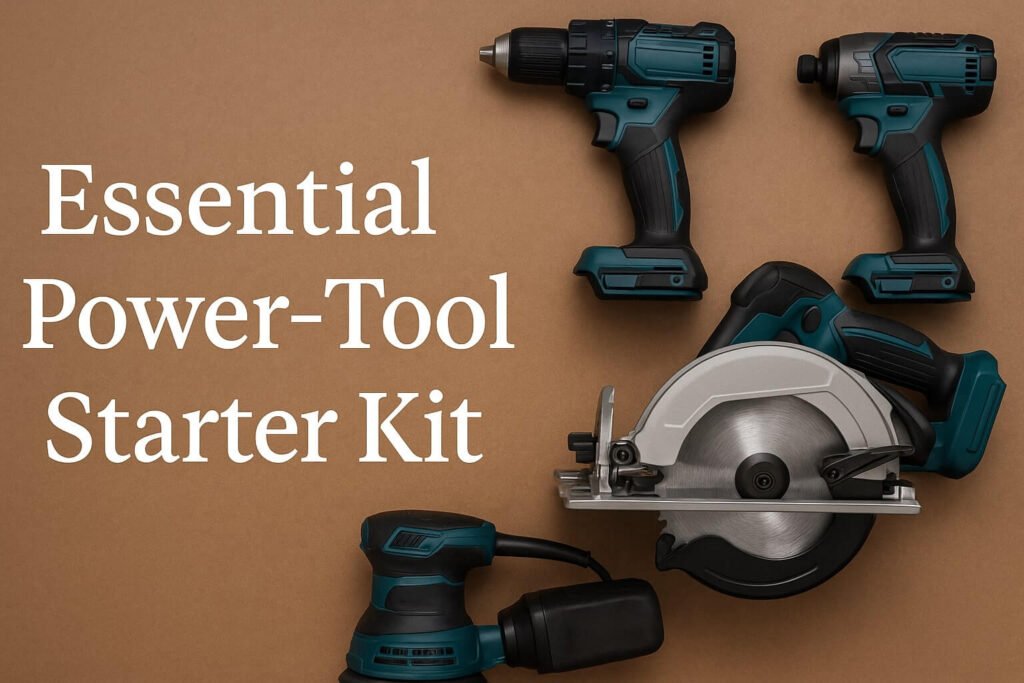There’s a moment every DIYer remembers—the first time you drill into a wall, cut a plank of wood, or finally fix that creaky kitchen cabinet. It’s a little thrilling, a little nerve-wracking, and totally addictive. But before you can build a bookcase or hang that floating shelf you’ve been eyeing on Pinterest, you need to build something even more foundational: your essential power-tool starter kit.
This post isn’t just a shopping list. It’s a hands-on, no-fluff guide based on real-world advice, tool tests, and lessons learned (sometimes the hard way) from weekend projects, trial runs, and garage upgrades. Whether you’ve just moved into your first place or you’re finally ready to break up with your landlord’s toolbox, this guide is for you.
Why Every DIYer Needs a Thoughtful Starter Kit
Too many beginners rush out and grab whatever’s on sale, only to end up with tools that don’t work together or, worse, collect dust. A solid starter kit is about building momentum, not just gear. If your tools share the same battery system, are lightweight but powerful, and cover 90% of beginner-level tasks, you’ll feel more confident and waste less time.
Think of it like starting a garden. You don’t plant every vegetable in the first week—you begin with the essentials, let your skills grow, then branch out.
What Belongs in an Essential Power-Tool Kit?
Here’s the real backbone of a beginner’s setup—eight tools that have pulled more than their weight across thousands of home projects:
1. Drill/Driver (18V–20V, with clutch)
This is your must-have tool for just about everything: pre-drilling holes, driving screws, hanging fixtures, and assembling furniture. Look for one that’s brushless and comes with variable speed settings. Trust me, it’ll be your sidekick on every single job.
2. Impact Driver
Think of this as the drill’s tougher sibling. It handles longer screws, denser materials, and deck frames without stripping or stalling. Once you try it, you’ll wonder how you ever managed without it.
3. Circular Saw
From cutting 2x4s to trimming plywood, a circular saw is your ticket to basic woodworking. It’s compact but powerful—and ideal for DIYers who don’t have room (yet) for a full table saw.
4. Reciprocating Saw
Need to demo old cabinets, cut PVC, or prune back a tree branch? This tool is your wrecking crew in a box. It’s not pretty, but it’s ridiculously effective.
5. Oscillating Multi-Tool
This one’s a bit of a sleeper hit. It sands, scrapes, trims, and sneaks into tight corners. Perfect for awkward tasks like flush-cutting door jambs or removing tile grout.
6. Random-Orbital Sander
No one talks about sanding until they’re knee-deep in a refinishing project. This tool smooths surfaces like a dream and preps wood for paint or stain without gouging the grain.
7. LED Work Light
Late-night projects in dark corners? A battery-powered work light keeps your hands free and your cuts precise. You’ll be shocked how often you grab it.
8. Compact Wet/Dry Vac or Blower
Not glamorous, but essential. Sawdust builds up fast. A cordless vac keeps your workspace safe and your lungs grateful.
Choose Your Battery Platform Wisely
This isn’t the sexy part, but it might be the most important. Pick a tool brand that offers a wide range of compatible tools and accessories using the same battery type. DeWalt, Makita, Ryobi, and Milwaukee are all solid choices. Once you invest in a platform, future tools cost less and stay easier to use.
A quick tip from experience: Don’t mix battery systems early on. Stick to one brand, build slowly, and only switch once you outgrow the original lineup.
Safety Should Never Be an Afterthought
If you’re a beginner, investing in basic safety gear is non-negotiable. Get a pair of ANSI-rated safety glasses, snug-fitting work gloves, and hearing protection. A simple clamp set and a stable workbench can also prevent a lot of accidents before they even have the chance to happen.
Also—clean your tools. A wipedown and air blast after each project adds years to their lifespan. Batteries last longer if you store them inside and avoid running them below 20%.
What You Can Tackle First
So you’ve got your essential power-tool kit—what now?
Here are three perfect beginner projects to try:
- Install a floating shelf: learn wall anchors, levels, and screw depth.
- Build a basic bench or planter box: practice cuts, assembly, and finish.
- Create a feature wall: use your sander, nailer, and multi-tool for a transformation you’ll love.
Each one teaches new skills and gets you more comfortable with your setup.
Real Talk: What to Spend
For most beginners, a reliable kit lands between $250 and $600 depending on brand and battery size. Here’s a rough tier guide:
- Budget-friendly: Ryobi ONE+ ($289–$349 for 6 tools)
- Mid-range: Craftsman V20 Brushless ($299–$379)
- Premium: Milwaukee M18 Fuel or DeWalt XR ($500+)
Unless you’re building a house next month, a mid-tier kit will serve you well for years.
Final Thoughts: Build Slowly, Build Smart
Every DIYer’s journey starts somewhere. Your first essential power-tool kit isn’t about owning everything—it’s about unlocking what you can build. Over time, as your confidence grows, you’ll figure out what you love doing most and which tools deserve an upgrade. But with this core eight and a solid battery platform, you’re off to a strong start.
Got a tool or two already? Want help figuring out your next smart buy? Drop a comment or shoot over your project ideas—I’d love to help.


